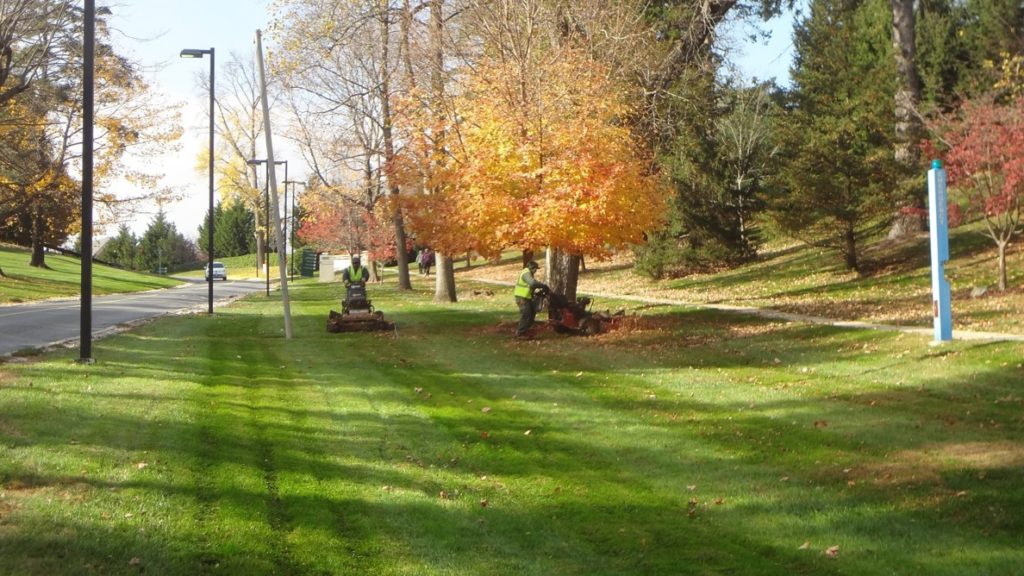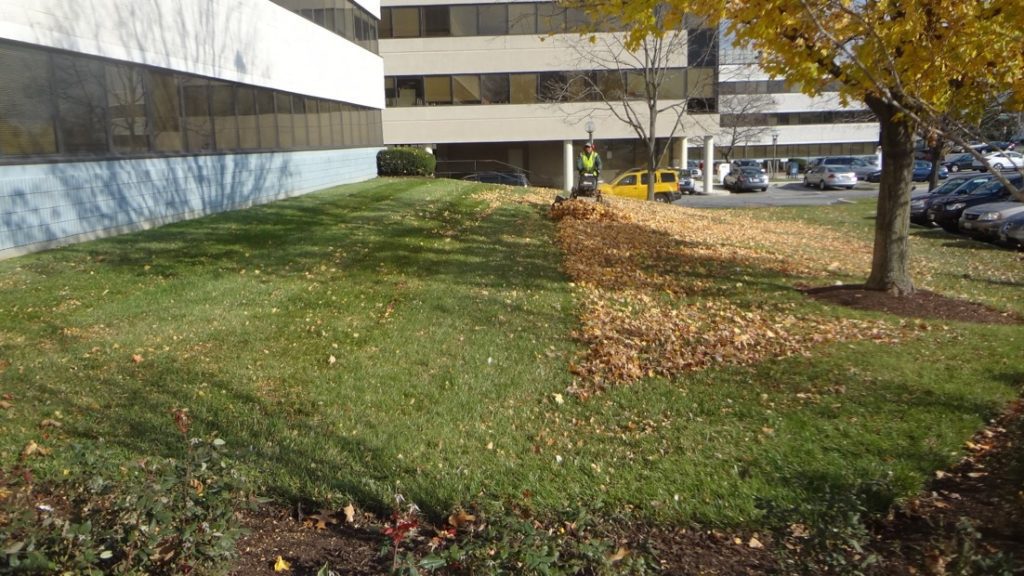 By: Joe Ketterer, Director of Quality & Efficiency
By: Joe Ketterer, Director of Quality & Efficiency
Tired of hot, humid, rainy weather? It’s time for cool, crisp air and the sights, sounds and smells our senses associate with autumn. As the seasons change, so must our perception of how one of our most prevalent and daunting landscape operations is accomplished. I am referring to what happens to the leaves as they morph from their beautiful displays of red, yellow and orange while on the trees to that brown blanket that covers our landscape when they fall. An accumulation of leaves can cause slippery pavement, clogged gutters and storm drains, messy entry foyers, and can impart an unmaintained appearance to properties and suffocate lawns.
In this edition of Coach’s Corner, my goal is to educate you to think more in terms of leaf management vs leaf removal for a number of economic and environmental reasons. After all, we are stewards of the environments where we live, work, and play.
 Typical maintenance contract specifications call for three leaf removal services in the fall. This is a bit of a misnomer—even though that is how we estimate the workload in order to budget some much-needed extra labor and specialized equipment costs, it is not how we typically perform the task in the field. The truth is, we actually start managing leaves in mid-summer when many tree species start dropping leaves prematurely due to heat, drought, or disease. Our crews are instructed to blow the leaves from the pavement into open lawn areas, then mow them into small pieces that fall into the turfgrass canopy, thereby recycling them back into the soil. Beginning in September and well into November, this process of blowing leaves first and mowing second continues with each progressive maintenance visit, which are usually 7-10 days apart. Each visit becomes more and more challenging as the volume of leaves increases.
Typical maintenance contract specifications call for three leaf removal services in the fall. This is a bit of a misnomer—even though that is how we estimate the workload in order to budget some much-needed extra labor and specialized equipment costs, it is not how we typically perform the task in the field. The truth is, we actually start managing leaves in mid-summer when many tree species start dropping leaves prematurely due to heat, drought, or disease. Our crews are instructed to blow the leaves from the pavement into open lawn areas, then mow them into small pieces that fall into the turfgrass canopy, thereby recycling them back into the soil. Beginning in September and well into November, this process of blowing leaves first and mowing second continues with each progressive maintenance visit, which are usually 7-10 days apart. Each visit becomes more and more challenging as the volume of leaves increases.
It’s important to note that we are performing leaf management services over the course of several weeks and may actually need to mow more frequently because of the difficulty in mulching leaves AND mowing excessive grass clippings all at once. This mow/mulch process will eventually culminate in the need for actual leaf removal in most markets, usually sometime in November, due to the sheer volume of leaves making it too difficult to simply mulch in place. It is at this point that we generally resort to using more expensive and specialized equipment (i.e. a leaf vac or tarped/box truck) to physically haul the leaves away to be composted because leaves/yard waste are no longer welcome in traditional landfills since legislation was passed back in the 90’s.
The three leaf management options are:
1. Mulch the leaves in place in an open turf area
2. Blow the leaves into a surrounding native area within the property boundaries and let them decompose naturally (with customer approval)
3. Remove the leaves with a leaf vacuum and dispose of them off-site (the most costly option)
There are those who oppose the idea of disposing of leaves by mulching into existing turf areas as a potentially harmful or undesirable process. However, extensive university research has identified a number of economic and environmental advantages to this method of leaf management. These advantages are well documented by several prominent agricultural schools—Purdue, Michigan State, and Virginia Tech, just to name a few—that promote this practice when done in conjunction with other sound turf grass management practices. Some of the most notable advantages include:
 Leaf mulching into existing turf grass can reduce (but not replace) the need for supplemental nitrogen fertilizer inputs from conventional lawn care programming. It also helps comply with nutrient management laws aimed at improving water quality in our lakes, rivers and bays/estuaries.
Leaf mulching into existing turf grass can reduce (but not replace) the need for supplemental nitrogen fertilizer inputs from conventional lawn care programming. It also helps comply with nutrient management laws aimed at improving water quality in our lakes, rivers and bays/estuaries.- Certain leaves (like maples) have been known to reduce dandelion and crabgrass infestations the following year by creating a mulch barrier and releasing a naturally occurring chemical during its bio-degradation process. (This, however, does not replace the need for applying a synthetic pre- or post-emergent herbicide.)
- Why waste time/labor dollars and pay expensive dump fees to remove leaves when you can compost them right back into your existing soil? This will increase the organic matter content to help improve soil structure for nutrient retention and future root zone development, leading to a healthy, green, and dense lawn over time.
I hope you find this article helpful in understanding why we all need to think more in terms of leaf management vs. leaf removal, as the pros far outweigh the cons. We rely on frequent communication between our area/field managers and the property managers to determine which option best meets the customer’s needs. As with many experiences in life, too much of anything is seldom a good thing and can lead to other issues. The rule of “everything in moderation” can certainly apply here. Mulching leaves in place is the best practice as long as it is done with common sense and we leave the property in better condition upon our departure. Please feel free to contact me at jketterer@ruppertcompanies.com if you would like more information on this important part of our basic landscape maintenance services. Enjoy all the best the season has to offer!
 By: Joe Ketterer, Director of Quality & Efficiency
By: Joe Ketterer, Director of Quality & Efficiency Leaf mulching into existing turf grass can reduce (but not replace) the need for supplemental nitrogen fertilizer inputs from conventional lawn care programming. It also helps comply with nutrient management laws aimed at improving water quality in our lakes, rivers and bays/estuaries.
Leaf mulching into existing turf grass can reduce (but not replace) the need for supplemental nitrogen fertilizer inputs from conventional lawn care programming. It also helps comply with nutrient management laws aimed at improving water quality in our lakes, rivers and bays/estuaries.